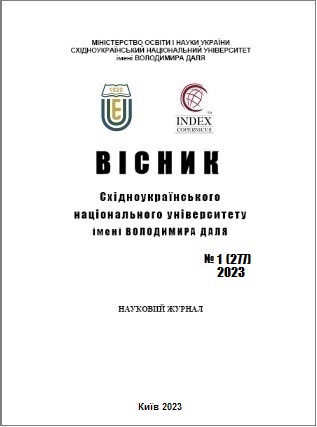Mathematical representation works of the three-shelf gas reactor in ammonia production
DOI:
https://doi.org/10.33216/1998-7927-2023-277-1-48-54Keywords:
mathematical model, three-shelf gas reactor, ammonia production, optimal process parameters, synthesis gas, bullshit optimization, deterministic modelAbstract
To achieve high efficiency of optimization and control of complex technological objects, the use of a combined mathematical model is a key aspect. This approach allows you to take advantage of both approaches: experimental-statistical and deterministic, providing high adequacy, easy adaptation and a wide range of applications.
In this paper, such an approach is proposed for developing a mathematical model and optimizing the control of a complex technological object - a three-shelf gas reactor for ammonia production. The first step in the development of the model is the creation of a deterministic model that allows one to evaluate the criterion function and identify the area of the global extremum. Despite its low accuracy, the deterministic model allows you to evaluate various options for the process parameters and determine what to change to improve the operation of the object.
The second stage is to adapt the model based on experimental data using probabilistic methods. This allows you to get a more accurate model, taking into account all the impacts affecting the object. An adequate model should take into account the nonlinearity of the dependence of the initial process parameters on the input ones, which can lead to complex mathematical equations for describing the control object.
Where approximate solutions are used, various analyzes and checks can then be carried out to evaluate the accuracy of these solutions and their suitability for use in a particular situation. In particular, the following analyzes can be carried out:
- comparison of the approximate solution with the exact decoupling (if known) to determine the error;
- conducting a sensitive analysis to assess the impact of changing parameters on the solution results;
- performing a robustness analysis to determine how small changes in initial conditions or parameters affect the outcome of a solution;
- carrying out verification to determine whether the approximate solution satisfies the modeled equations of physics;
- carrying out validation to check how accurately the approximate solution reflects the experimental data or observation.
As a result of such an analysis, it can be established whether approximate solutions are suitable for use in practical applications or whether more accurate solution methods should be used.
References
1. Амелин А.Г. Общая химическая технология [Текст] / А.Г.Амелин, А.М.Кутепов – М.: Химия, 1977. – 324 с.
2. Абдалхамид, Д. Адаптація мат моделі реактора синтезу метанолу / Д. Абдалхамид, М. Г. Лория, А. Б. Целищев, П. Й. Елисеев, И. И. Захаров // Восточно-Еврорпейский журнал передовых технологий. – Т. 6, № 3 (66). – 2013. – С. 4–7.
3. Стенцель Й.І. Автоматизація технологічних процесів хімічних виробництв: Підручник [Текст] / Й.І. Стенцель, О.В. Поркуян - Луганськ: вид-во Східноукр. нац. ун-ту ім. В. Даля, 2010. – 300 с.
4. Математичне моделювання технологічних об’єктів [Текст] : Пыдручник / О.Б.Целіщев, П.Й.Єлісєєв, М.Г.Лорія, І.І.Захаров – Луганськ. Вид–во Східноукр. нац. унів. ім. В. Даля, 2011. – 421 с.
5. Принципы математического моделирования хи-мико-технологических систем [Текст] / В.В.Кафаров, В.Л.Перов, В.П.Мешалкин и др.– М.: Химия, 1974. - 344 с.
6. Абдалхамид, Д. Система экстремального управ-ления многополочным реактором с моделью / Д. Абдалхамид, М. Г. Лория, А. Б. Целищев, П. И. Елисеев // Вісник СНУ. – № 15 (186), Ч. 2. – 2012– С. 152–156.
7. Абдалхамід Д. Динамична модель газового ре-актора / Д.Абдалхамід, М.Г.Лорія, О.Б.Целіщев, П.Й.Єлісєєв //ВОТТП. - №4. – 2013. – с. 31-35.
8. Абдалхамид Д. Разработка комбинированной модели для задач оптимизации / Абдалхамид Д., Лория М.Г., Целищев А.Б., Єлисеев П.Й. // Наука и техника. - №3. – 2014. – с. 23 – 28.
9. Банди Б. Методы оптимизации. Вводный курс[Текст] / Б.Банди. Пер. с англ. - М.: Радио и свіязь, 1988. – 128с.
10. Второй фронт ХТС. The Chemical Journal, Сен-тябрь 2002, с.50-54
11. Spatial Self-Organization in One Process of Chemical Technology [Text] : International Conference on Differential Equations and Dynamical Systems., 1-4 August 1997. Canada. Watérloo : 1997. - P. 166.
12. Thermal Spots in an Industrial Packed Bed Catalytic Reactor [Text] : Year 2000 International Conference on Dynamical Systems and Differential Equations (ICDSDE) Abstracts Book. USA, Kennesaw, 2000. - P.81.
13. Fuzzy Modeling for Control [Text] : Kluwer, 1998. – P. 122.
14. Driankov, D. Palm R. Advances in Fuzzy Control [Text] / D.Driankov, R.Palm // Physica-Verlag. Heidelberg. Germany - 1988. P. 129-137.
15. Pedrycz, W. An Introduction to Fuzzy Sets: Analy-sis and Design. [Text] / W.Pedrycz, F.Gomide // MIT Press. Hardcover. - 1998. №2. – Р. 24-41.
16. Seraya O.V., Demin D.A. Linear regression analysis of a small sample of fuzzy input data (2012) Journal of Automation and Information Sciences, 44 (7), pp. 34-48.

